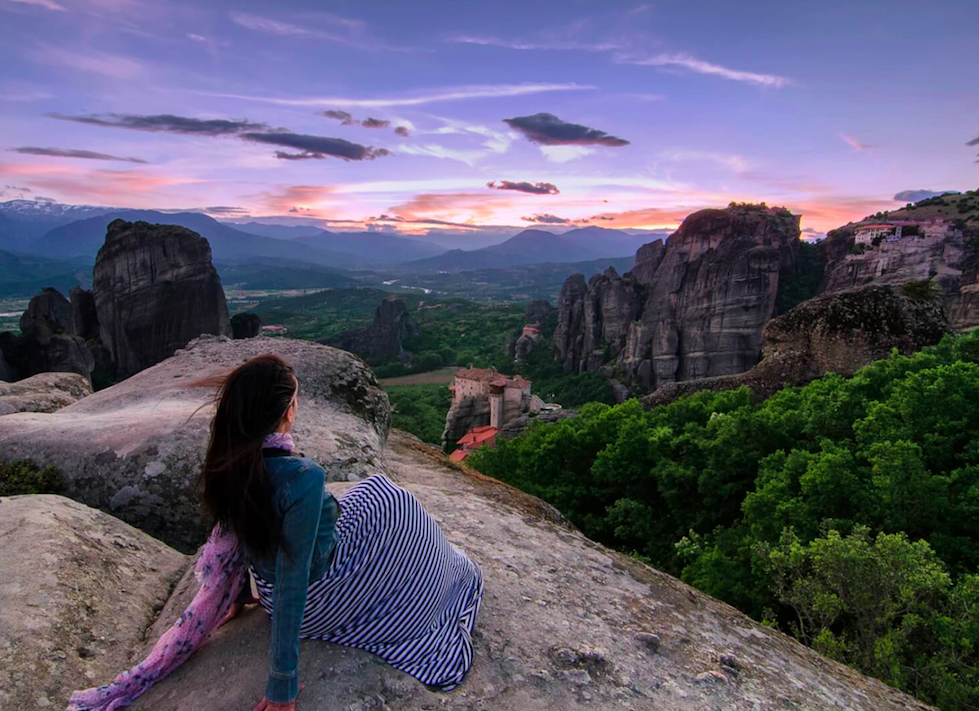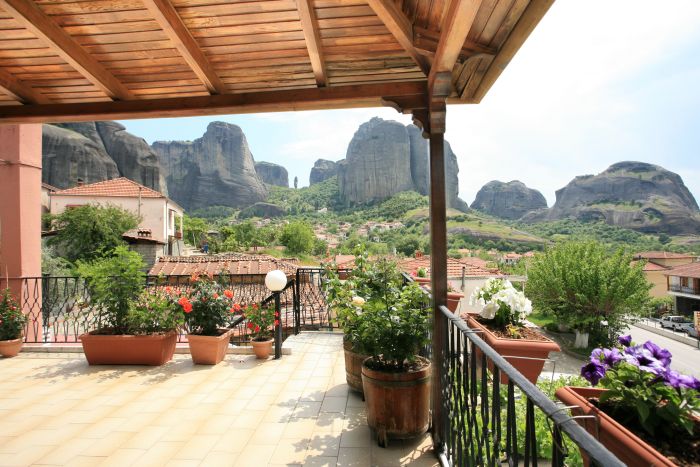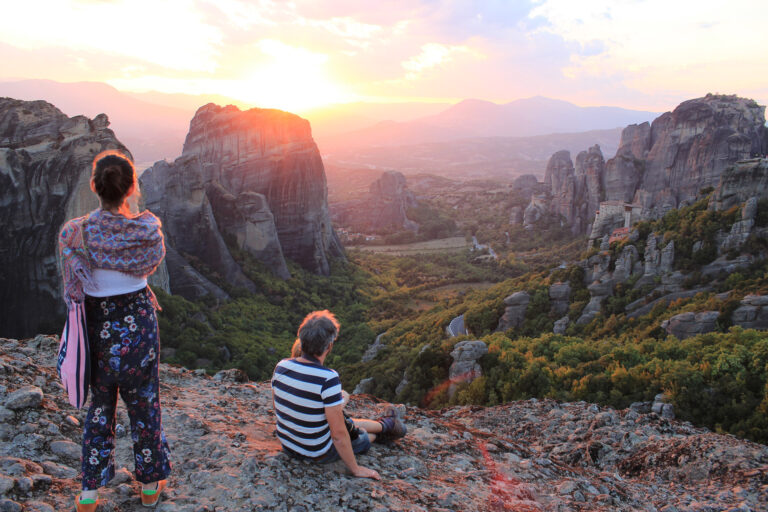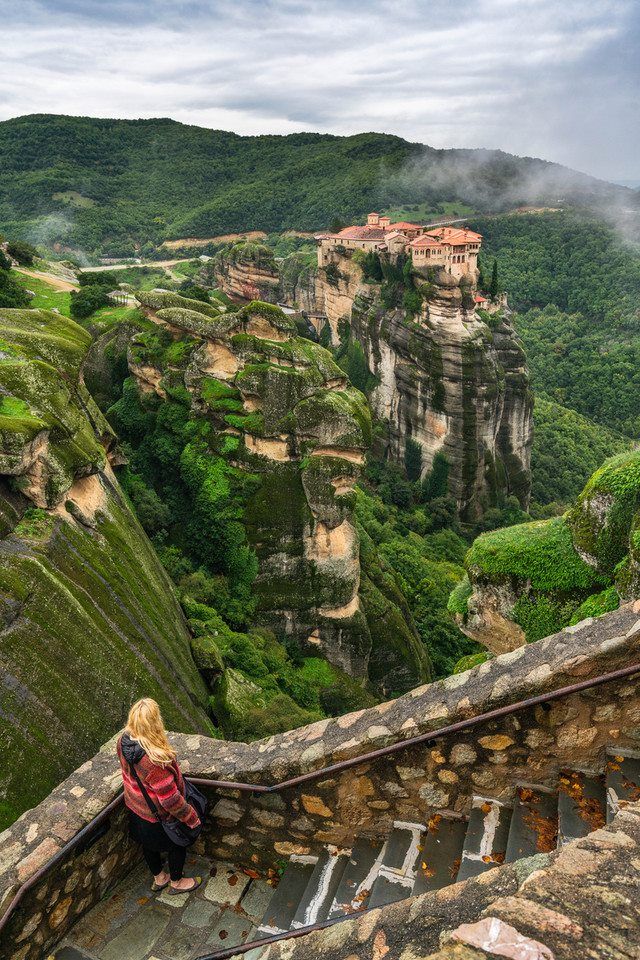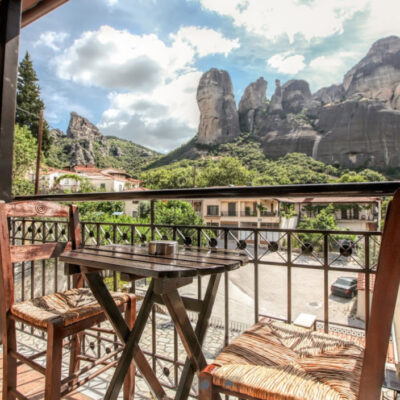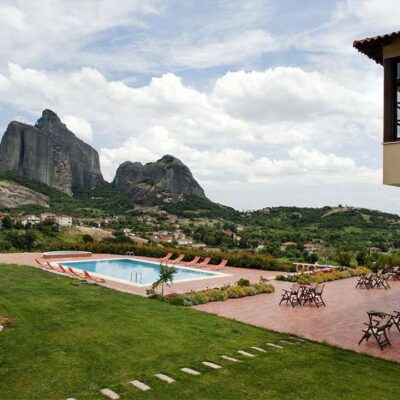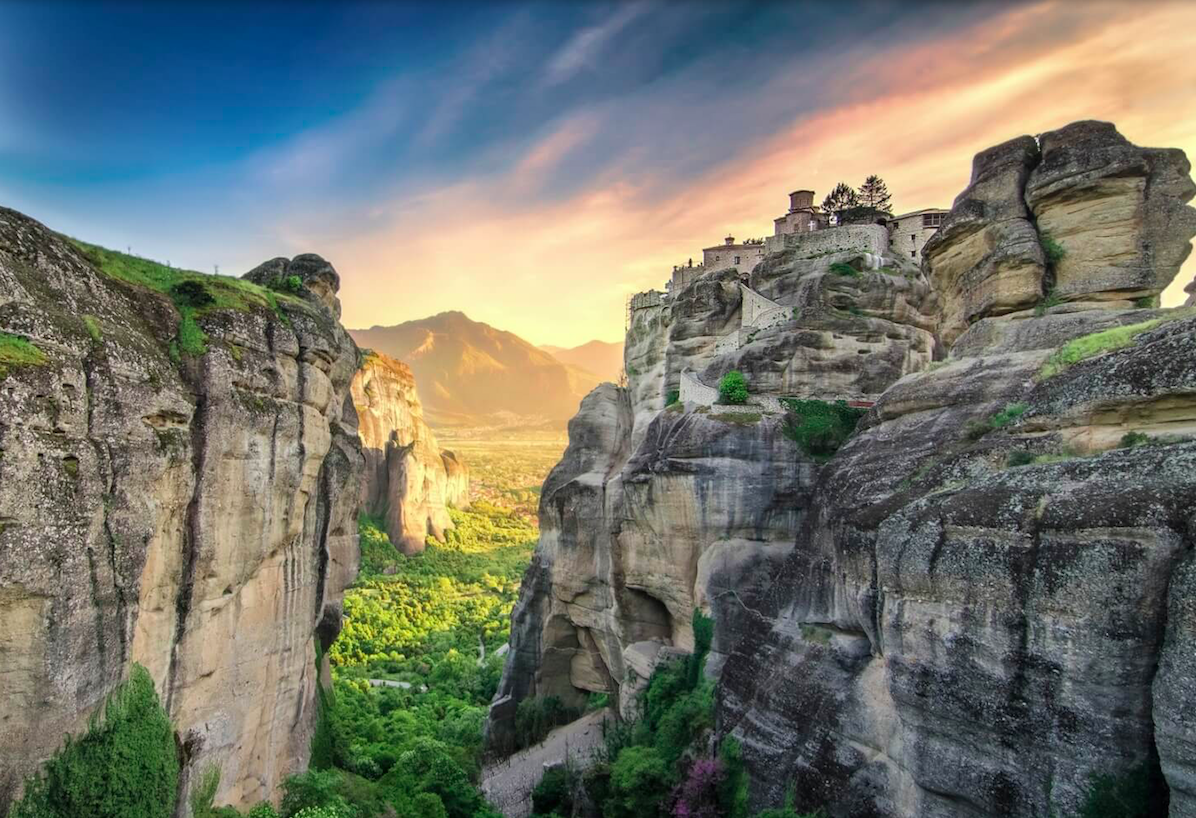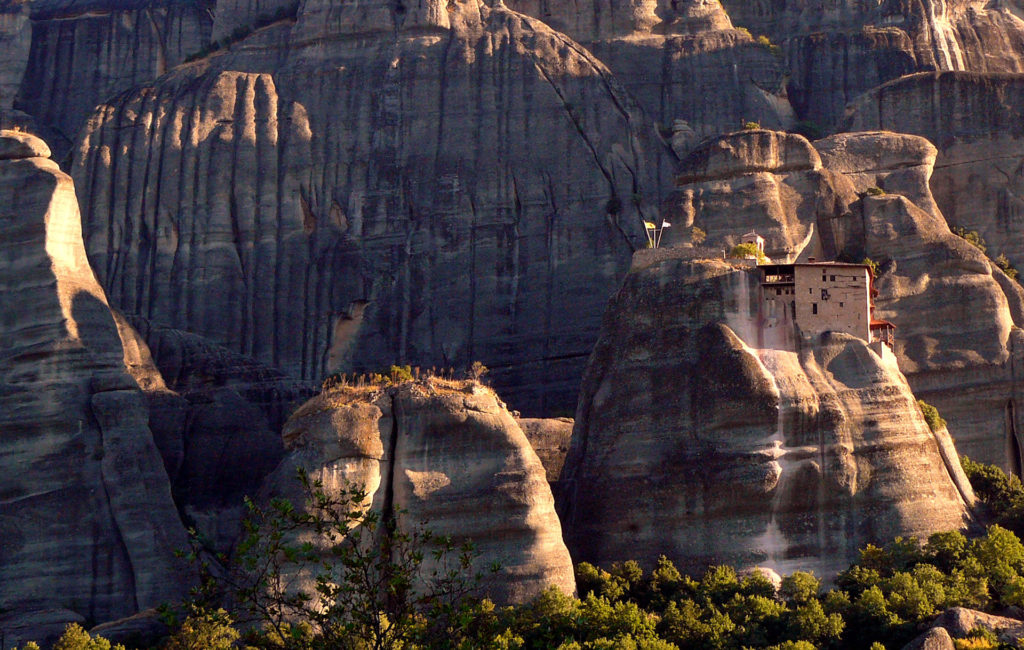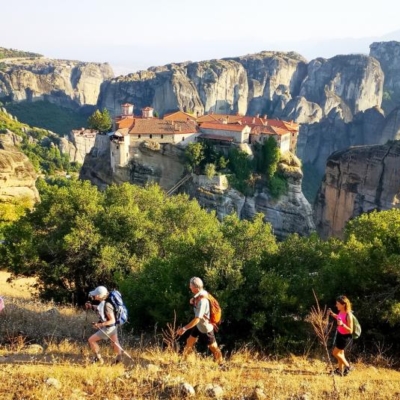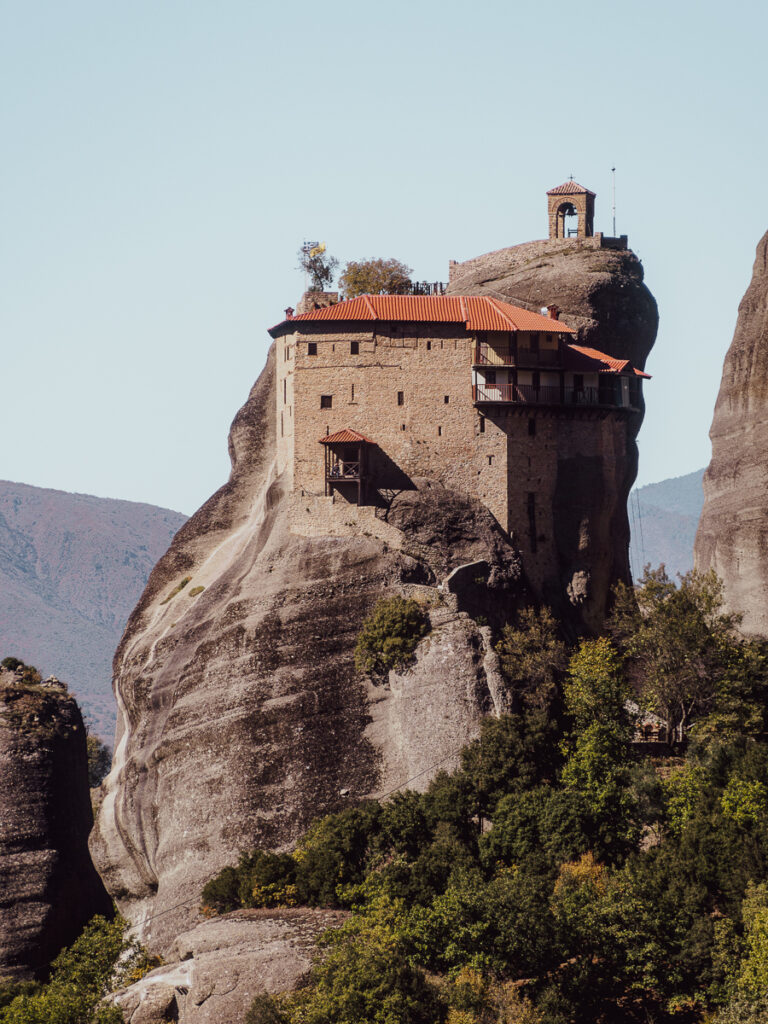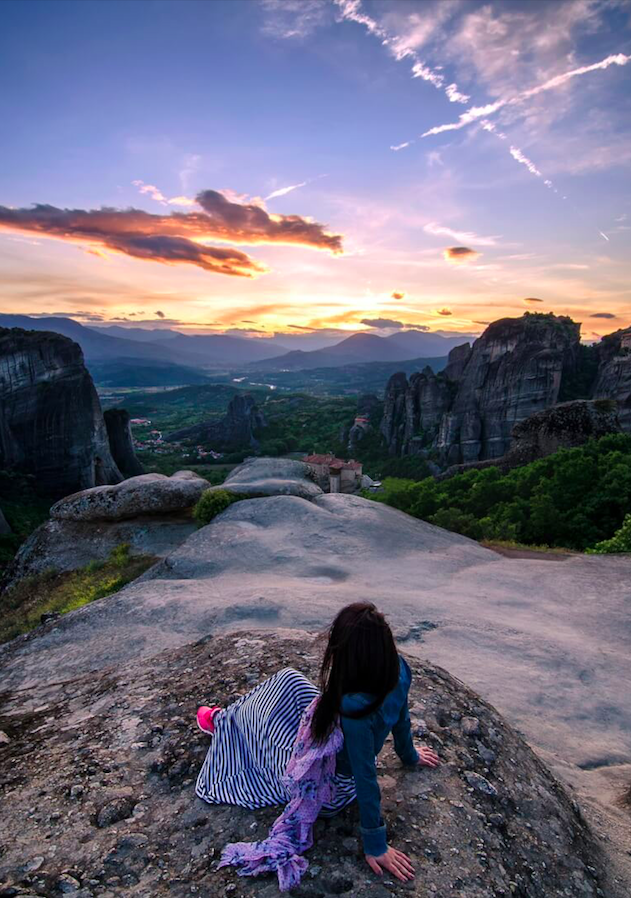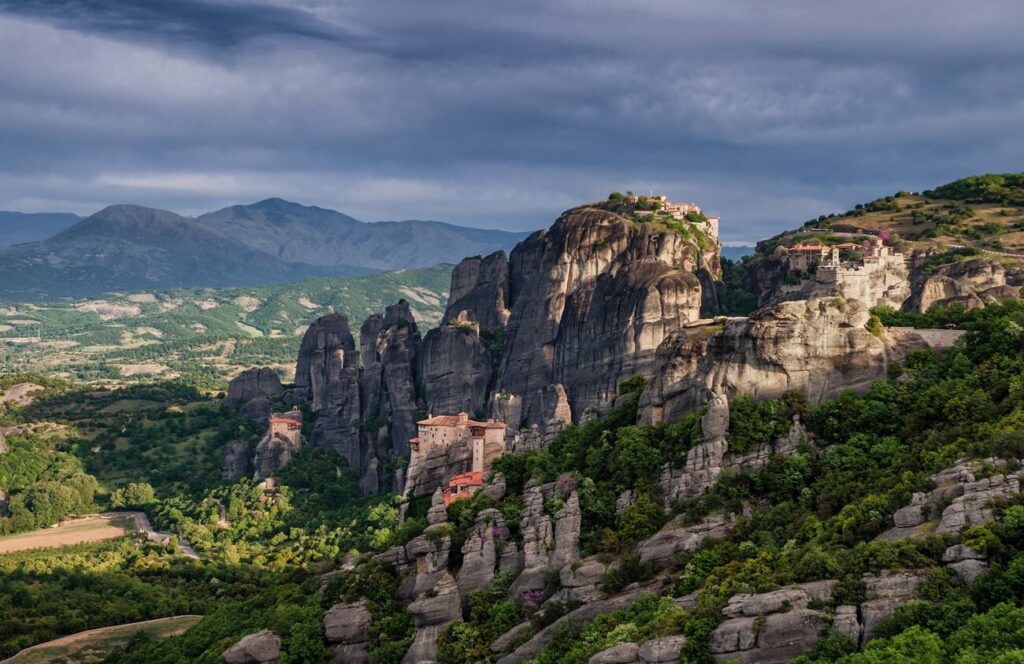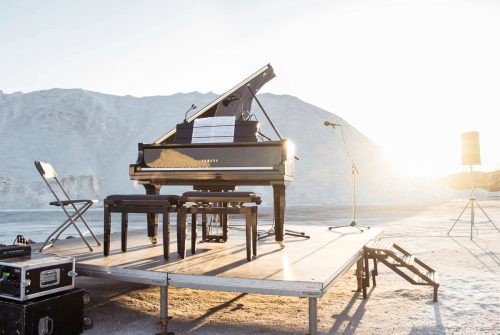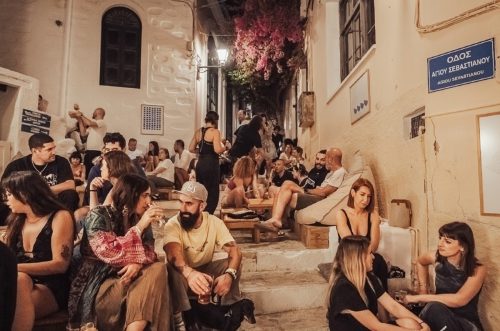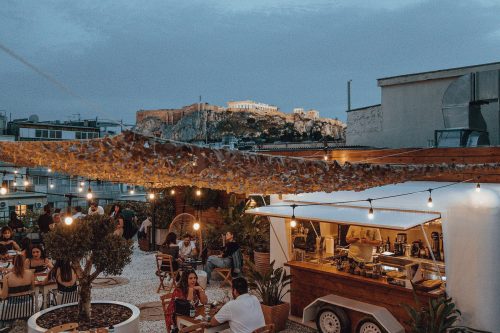Meteora, famous for its monasteries perched atop vertical peaks, is the most jaw-dropping destination. Its name literally means ‘suspended in air’ because in the 9th-century hermit monks were the first to climb these soaring stones to settle in the caves and hollows of the rocks.
Nowadays, pathways and stairways have replaced baskets and ropes and undoubtedly, it’s a destination in Greece that shouldn’t be missed. From 24 monasteries, today six of them remain active and are run by monks and nuns. Meteora is a Unesco World Heritage and archaeological site and the Greek State has officially declared it as a Holy Place.
What you need to know before you arrive
Entrance to the monasteries for Greeks and Cypriots is free. For the rest, in each monastery, there is an entrance fee of 3 euro per person. Kids up to 12 years old don’t pay.
If you have less than 24 hours to spend at Meteora, plan to visit 2 or 3 monasteries as for each of them you need an hour minimum.
There is at least one fountain with cold water inside every monastery if you need to refill your bottle. There are no restaurants, so also take some snacks with you.
At the entrance of the monasteries, clothing is provided only to women. Men are not allowed to enter if they are wearing shorts above the knee or sleeveless shirts. In any case, dress appropriately.
The Monastery of the Holy Trinity and Great Meteoro has over 300 steps. Rousanou, Varlaam, and Saint Nicolaos have an average number of 140. The Holy Monastery of Saint Stephen is connected with a walking bridge, so it’s more accessible than any other monastery.
Check the opening hours of Meteora monasteries here.
Getting there
The most convenient way to visit Meteora is by car and the most scenic is by train. The duration from Athens by train is 5 hours (transfer at Paleofarsalos), by public transport (KTEL) is 4.5 hours (transfer at Trikala) and 3.5 hours by car. From Thessaloniki by train is 3 hours (transfer at Paleofarsalos), by KTEL is 3 hours (transfer at Trikala) and 2.5 hours by car.
Where to stay- Most travelers who visit Meteora stay in Kalambaka city or Kastraki village.
Tips for getting around
If your hotel is at a central spot in Kalambaka and Kastraki you can move around by car or on foot.
To avoid traffic jams or difficulties to find parking spaces outside the Monasteries of Great Meteoro, Varlaam, and Agios Stefanos (from May till late October), try to be outside those Monasteries before 9 am. An alternative way is to leave your car in the hotel and join one of the tours offered by locals.
There are public buses between April and October starting from Kalambaka at 9 am in the morning and every 2 hours till 5 pm in the evening. It’s convenient to use it as a one-way trip rather than like a hop-on, hop-off bus from monastery to monastery. You can check the bus timetable to Meteora here.
Best time to visit- Spring and Autumn offer pleasant weather and the crowds are tolerable. Winter is out of the question if you want to hike on trails or climb up to monasteries because of the cold or snow.
Where to sleep
The traditional Alsos House for the amazing view.
Grand Meteora Hotel, located at the foot of Meteora, in the heart of the Thessaly plain, is a fascinating experience of sights, colors, and scenery.
Dellas Boutique Hotel, built of stone and located at the foot of the rocks of Meteora, in the village of Kastraki.
Where to eat-
Meteora Restaurant offers classic dishes, slow-cooked stews, and casseroles. (A: Trikalon 2, Kalambaka)
Panellinion, located on Kalambaka’s central square. The restaurant’s most famous dish is the lamb chops with roast potatoes and rice. (A: Eythimiou Vlachava 20, Platanos Square, Kalambaka)
Valia Caldahere you will find traditional Greek food cooked with the freshest local ingredients. (A: Trikalon 91, Kalambaka)
Elia’s Garden features traditional delicacies and a cellar full of all kinds of Greek wines. (A: Trikalon 149, Kalambaka)
Archontariki offers traditional Greek cuisine with fresh ingredients. (A: Trikalon 13, Kalambaka)
What to eat- The must-eat dish is Mutton (kebab or chops).
Where to drink…
Cafe Diverso in Kalambaka’s central square.
Aroma Mentas, with charming decorations it is great for coffee or dessert.
Aerino, a nice place, decorated in stone, from where you can see the rocks of Meteora.
Discover history-
Scientists believe that these magnificent rocks were formatted about 60 million years ago. At that time, the area was covered by the sea. Several earth movements caused the seabed to withdraw. Extreme weather conditions, strong winds, and waves formed their shape.
During the Byzantine times, monks had the inspiration to construct monasteries on top of these rocks so that they would be closer to God. The foundation of Meteora monasteries began around the 11th century.
In the 14th century, Saint Athanasios established the Holy Monastery of the Transfiguration of Jesus and named this huge rock Meteoro, which means hanged from nowhere. This monastery is also known as the Holy Monastery of the Great Meteoron, the largest of all monasteries. Monks used scaffolds in order to get supplies and climb the rocks. Afterward, nets with hooks, baskets, and rope ladders, or even wooden ladders of 40 meters long followed.
Between the 15th and 17th centuries, many monks from other monasteries and people who wanted an ascetic life arrived at Meteora but the prosperity of Meteora started to fade away after the 17th century mainly due to the raids of thieves and conquerors. As a result, many monasteries were abandoned or destructed. Today, only 6 monasteries operate and the only nunnery (female monastery) is the Monastery of Agios Stefanos.
Must visit villages –
The small and picturesque village of Kastraki with houses made of stone, embellished with roofs of red clay tiles, has an authentic local character of the old times. The village of Kastraki has been classified by the Greek State as a traditional resort under preservation, three consecutive times.
Culture & Traditions of Meteora
There is a unique tradition that started back in Ottoman times and takes place every year after Easter in the small village of Kastraki. On the day of the celebration of Saint George, many people with colorful scarfs in their hands and belts gather early in the morning underneath a cave. When their belts are full with scarves they head to the bottom of the rock, grab the ropes and they start to pull themselves up. In the middle of the rock, there is a cave full of scarves from the previous year. When the climbers reach that point, they enter and suddenly you can hear them singing and dancing. After that they replace the old scarves with the new ones, they brought up there. In the end, they come down with the old scarfs while the people gathered around them, reach their hands to take a fainted small piece of a scarf. Finally, they all gather at the village’s square, singing, and dancing in circles.
According to the legend, a couple of Turks went underneath the chapel of St. George to cut wood for the fire. Suddenly, a tree fell and seriously injured the man. His wife (even though she was Muslim) prayed to St. George. Her husband was immediately healed, so she offered the most precious thing she had, her hijab. Nowadays we offer scarfs in exchange for good health and we keep the old scarfs as talismans for good luck.
Do as locals do
The true locals of Meteora are the… monks and nuns. They are part of a community and they have three basic rules: Purity, lack of property, and obedience. They pray and fast according to the rules of the Orthodox Church the whole year. They wake up at 3:30 am in the morning in order to pray in their cells until 5:00 am. From 05:00 until 07:30 they have the services of Midnight, of Matins, and of Hours that take place at the church.
Top activities-
Hiking. Alone or with a group, through a 7.5km-long route where you will enjoy the jaw-dropping landscape.
Rock Climbing. Meteora is one of the most well-known rock-climbing sites in the world, with more than 1,000 paths, with all levels of difficulty.
Μountain bike. Riding a bicycle can lead you beyond the mainstream paths in order to discover the hidden treasures of Meteora.
Truffle Hunting. An alternative tour that starts with the search for black truffle in the forest and after a break with a picnic with truffle-spaghetti, concludes with a tour of the Museum of Natural History and Mushrooms.
Where to shop-
In all the monasteries there are interesting icon stores (usually half the price of regular shops).
“Ekfrasi”: traditional Greek tourist shop in Kalambaka where you can find real leather sandals, t-shirts, and ceramics inspired by Ancient Greek mythology and various souvenirs, among others.
Maro Theodorou ceramic shop: In the heart of Kastraki village, a Kalambaka-born ceramicist sells her own pottery as well as works by other local artists.
What to see-
Holy Monastery of Grand Meteoron (or the Holy Monastery of the Metamorfosis- Transfiguration of Christ) is the oldest and largest of all the monasteries of Meteora. It is a male Monastery built on the greatest rock of the complex, the Platys Lithos or Playtlithos before the mid-14th century. Enjoy the courtyard and observe the amazing frescoes. There is also a sacristy with the skulls of the monks who have lived there over the years.
Holy Monastery of Varlaam is named after the first monk who built the first church on the rock. Unfortunately, after his death, the site was abandoned for 200 years. In 1517 two monks from Ioannina, Theophanes and Nektarios Apsarades, re-founded the monastery. You can reach the monastery by a bridge. There you can find a small museum and several impressive 16th-century paintings.
Holy Monastery of Rousanou, built in 1545, is dedicated to St.Barbara. You can reach the Monastery by a bridge. Nowadays, after the restoration of 1980, Rousanou Monastery is run by nuns.
Holy Monastery of St. Nicholas Anapafsas, founded in the 14th century, is most famous for its frescoes by the famous Cretan artist Theophanes Strelitzas in 1527. The monastery was completely abandoned for 60 years from 1900 to the 1960s when the Greek government repaired it.
Holy Monastery of St. Stephen, constructed in the 15th century, is run by nuns and is the closest monastery in Meteora to the main town of Kalambaka. During the Second World War, it was severely destroyed by German troops and the by the Greek civil war.
Museum of Natural History and Mushrooms, which houses approximately 300 exhibits of animals and several dozens of the main species of mushrooms. It’s the first of its kind in Greece.
Museum of Digital Projection (in Kalambaka) & Museum of Geology (in Kastraki), a journey through Meteora’s history via 3D movies and other audiovisual material.
The Rock in the cave of Theopetra, a prehistoric treasure, since it’s the place where the oldest human imprints in Greece were found (130, 000 years old).
The Antichassia-Meteora Natural Reserve, home to various species of flora and fauna that covers almost 830 hectares.
Take a day trip to-
Trikala, an exceptional city with a river, bridges, and bikes! Get lost in the old town and discover the alleys of Sakaflias, the fort, the Kursum Mosque, and the clock, among others. Don’t leave before you enjoy a boat ride in Litheos.
Don’t miss…
A walk in the serene village of Kastraki with the breathtaking view of the rocks.
Wine tasting. A five-minute drive from Kalambaka is the village of Diava, where the Loudas family has been producing wines since 2006. The Loudas Winehouse is the perfect place to taste some of Thessaly’s top wines.
Insider tips
–Do not park on Trikalon Street in Kalambaka because it is very likely that you will get a fine from the traffic police.
-Pay attention to the dress code for the monasteries. Kids up to 12 years old don’t have to comply with the dress code.
Ideal time to spend here? I would recommend at least 2 days stay in Meteora.
Favourite part? Watching the sunset at Psaropetra sunset viewpoint in Meteora (Most tourists watch the sunset from the viewpoint next to Varlaam). You can find Psaropetra beside the Rousanou nunnery parking lot.
What to avoid?
Skirts above the knee, shorts, and sleeveless shirts (for both women and men).
The monks don’t allow anyone to photograph the interiors of the churches and especially the murals, or in any of the museums located inside the Meteora monasteries. You can take photos or videos in the yards or any viewpoints.
Do not attempt to fly a drone inside or outside a monastery. It is strictly forbidden by law (flights restriction zone of up 4.000ft.) without written permission by the authorities.
Also, don’t take pictures or videos of monks or nuns, unless they specify otherwise. They can become upset by it as they are not tourist attractions. Be very respectful of their way of life.
Finally, you can’t leave until- Enjoying an evening car ride and enjoying the night scenery of Meteora, with the unique imposing dark figures of the rocks.
Main images by Polina Paraskevopoulou ©

